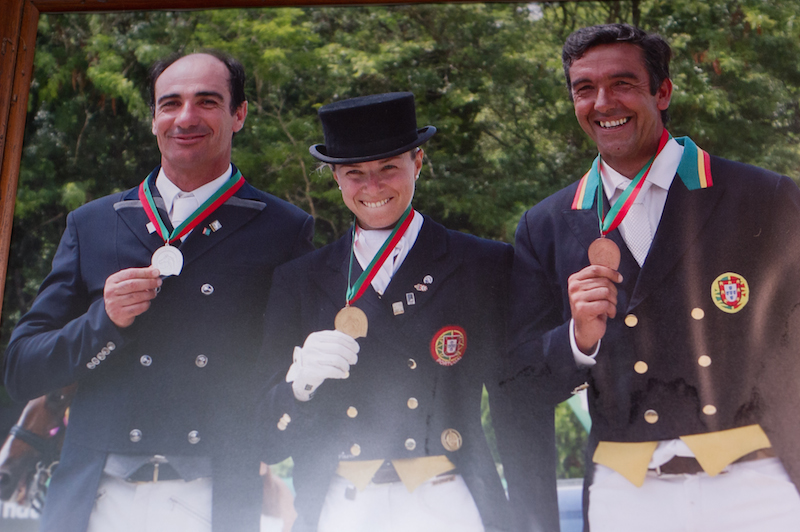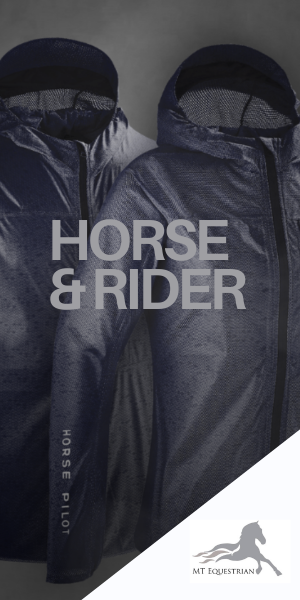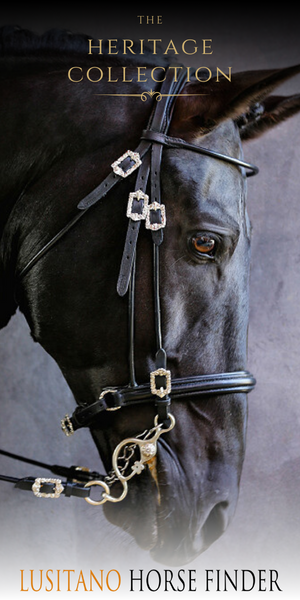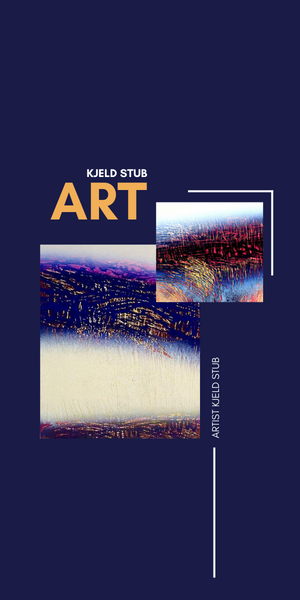“The Training Scales for Horses are the bridge between classical and modern dressage. The guidelines are the same. “
Written by Teresa Burton. Adapted by Rebecca B. Mender and Therese Alhaug. Photo: Lena Saugen
These words come from Paulo Caetano. He knows what he is talking about. Classical dressage is in his Portuguese veins and he combines it with being one of Portugal’s most famous bullfighters on horseback. He also hands down his deep understanding of riding to other riders, along with his daughter as his foremost representative.
Maria is a multiple national champion in dressage. She participated at WEG 2014 and Europeans this summer. Together they form a dynamic duo that administers and unite classical and modern dressage. Currently, this is a hot topic of conversation. Equilife visited the Caetano family where they talked about how they live and breathe for traditional riding and modern dressage, all in the same breath.
Paulo’s Story
The car spirals up the hill towards the Caetano family’s farm in Alentejo, on the border of Spain. The family breeds and trains their Lusitano horses there. In the car it becomes quiet. The nature and the surroundings are breathtakingly beautiful. Rolling hills, glimmering lakes, a haze of meadow flowers is accompanied by teeming birds. Bulls and horses graze happily on green, lush pastures. Then the house, stables, indoor arena and outdoor arenas come in sight. We have arrived.
Paulo welcomes us warmly. He is enthusiastic, confident of himself, of his profession and of his passion. His daughter, Maria, takes a break from her busy workday. Today it is reserved for fitting new saddles for her horses. She hangs up the saddle and walks with us to the house. Despite her being petite and slender, she rides dressage internationally. She is not reluctant to gallop over the rolling hills to herd cattle.
Paulo starts talking. He tells about a childhood tied to the farm where his grandparents bred cattle and black bulls. “My father was a contractor and worked mainly in Lisbon. He was a fantastic businessman, a remarkable father, very brave, intelligent and had a big heart. Even when I was a little boy he respected my dreams and ambitions of becoming a rider. Later he supported me in my decision of becoming a bullfighter on horseback, a so-called «rejoneador». I was the first of my family who chose such a career”.

“The sport horse is no pet. The sport horse is an athlete, and you are responsible for the horse’s progression. To achieve the goal you have to have a very trained eye, to have the ability to know what reactions will come, have the discipline to follow the right way. Most important of all is to know which way is the right way.”
Paulo Caetano
Young and Ambitious
Paulo has ridden from an early age. Just four years old he climbed up on a horse. Young Paulo had a dream and a goal. When he quit school at the age of 13, he crossed paths with one of the greats in bullfighting at the time. Paulo swallowed his timidity at meeting the star Antonio Badajoz. His goal was more important to him. Paulo was determined. «Hello,» he said with a tiny boy’s voice to the great master. Paulo was seen and answered.
“To my great joy, Badajoz stopped and asked who I was. I replied: I am Paulo Caetano and I want to be a bullfighter. Do you want to see me ride?”
The star noticed the determination in this young boy. He laughed and said:
«Yes, come, let’s go – I would like to see you ride». Three month’s later Paulo received his first bullfight contract, in Portugal in 1974.
Unsettling times lead to new choices
People in Portugal in the seventies experienced unrest and revolts. Historical incidents intervened in the lives of the Caetano family. In 1972, the army took over the government of the country and three years of communist rule started. The communists confiscated big houses, properties and farms to distribute these to the people. The result: Banks collapsed and businesses disappeared out of the country.
“During the revolution, I did, like many other Portuguese, leave the country. I went to Badajoz in Spain with my horses. My career as a bullfighter surged ahead there. I got many good friends – you know friends for life that I’m eternally grateful for. The Spaniards were good to me; they supported me, my horses and my ambitions”, he says.

New Tasks
In 1978, Paulo’s father handed over the reins of the Esquilas Farm in Monforte, Portugal to Paulo.
“This was my family’s favorite place. I continued with my passion as a professional rider and bullfighter despite my new life and responsibility. Bullfighting gave me the economic means to develop our two farms. In addition, I bought more land. It was at this time I started to breed Lusitano horses”.
Paulo had an agricultural mentor that became important to Paulo beyond that which dealt with cattle and herds. Antonio Moura was the father of the young girl Dita.
“The meeting with Dita is forever etched into my mind. She used to ride a little moped to the farm to watch me train. Every day she came to the riding arena. A young, almost childlike being, she was very quiet and a little timid, but completely wonderful.
We married two years later and the year after that their son João was born. Their daughter, Maria, followed three years later. Both João and Maria have chosen to become professional riders, to our great pleasure. We have strong family ties and we work together in the breeding and training of horses”.

“I believe we have woken up the golden days again by good riding. I think riders will return more and more to the classical principles”
Maria Caetano
Formed by the Classical Masters
Paulo speaks warmly and gratefully about his trainers and instructors.
“I have been a lucky fellow when it comes to being with the masters. I have had the opportunity to train with classical masters and that has changed me, he says”.
“Antonio Badajoz taught me everything that was to know about bullfighting, both the art of it and all the rules linked to it. He also taught me all the secrets of the wild bulls, all the important details about their reactions out in the fields and in the arena. It makes an enormous difference to have this knowledge and understanding. “
In equestrian matters, his own uncle Fernando Metzner Serra, was his first master, when Paulo was four years old.
“His knowledge of riding had German origin and he shared his knowledge generously with me”.
To learn and understand classical dressage Paulo went back in time to the great masters.
“What taught me the basics of classical riding was the study of earlier times’ grand masters like Pluvinel, Robichon de La Gueriniére and Baucher. To me, they are the indisputable masters. I have learned all my basic principles from them”.
Paulo’s uncle also led him close to the great masters of that time in Portugal. His uncle was a close friend of João Branco Nuncio and Nuno de Oliveira – the leading icons of classical riding in Portugal.
“My uncle taught me about horse morphology and movements in addition to 18th and 19th-century riding. My father’s friend, the Count da Córte taught me classical training and about the Training Scales for Horses. My father’s other friend João Parreira Cano taught me about dressage as a sport and a discipline. I have always been passionate about the possibility to study and ride with the great masters. I have found out that they have always been open and ready to share their knowledge”.
” It is important to understand the influence of the German masters as well. They made a bridge between the exercising of the horse and the importance of developing the horse’s body and mind. They followed an intelligent, structural method.”
Paulo Caetano
Paulo is filled with gratitude for the wide knowledge these masters have given him. The most important they have taught him, however, is the same.
“All these masters I have met across disciplines, have given me knowledge in different ways, and in different areas. But all of them have taught me the importance of respect for, and love of the horse. They have given me a solid base to build on”.
Paulo has been taught by many masters. But he does not feel fully qualified. Two- and four-legged ones contribute every single day to his learning more.
“The most important thing is that I haven’t ceased learning. I have many friends and masters I learn from today. I know that I may learn something new every day. I like to think that there is a progression in my riding. And my horses remind me of this every single day. They tell me: «Hello you, try to do fewer errors today!»

“Maria trained a Lusitano horse for some days, and then she performed a nice Prix St. Georges. What nobody knew was that I rode the same horse the next day in an important bullfight.”
Paulo Caetano
The Fabulous Horses
Paulo leans back in his chair and reflects on good memories and nice stories. His eyes shine brighter, he is eager. Laughing with a proud trace in his voice, he relates:
“My daughter, Maria was to compete in her second European Championships as a young rider. Those days she rode warmblood horses, and her horse White Cedar was on his way to Austria for the championships. Then a friend of hers asked her if she wanted to ride a Prix St. Georges-class here at home. Maria turned to me. «Dad, I have a problem. I really want to do this, but I have no horse here. » No problem, I said. Take one of mine.
No sooner said than done. She trained a Lusitano horse for some days, and then she performed a nice Prix St. Georges. What nobody knew was that I rode the same horse the next day in an important bullfight. He was one of my best horses. This shows how important basic classical training is. Another horse, Sole Sombra, had such a solid and elementary education of classical riding that I only needed two weeks training to get him ready for the bullfights. We performed very well together. A month later I sold him to a German dressage rider. What a horse!”

” For me, the good horses are good horses no matter what breed they are. But it gives me a bigger pleasure to represent my country on a Lusitano.”
Maria Caetano
His heart beats for breeding.
Breeding lies close to Paulo’s heart.
“I am proud to say that two Lusitano horses, which I have bred and trained, were chosen to participate in the World Equestrian Games, WEG, in Kentucky in 2010. The horse Util competed for the Portuguese team and the other horse for Brazil.
The goal of the family is to compete with their home-bred horses.
“I am very proud of breeding the three best 4-year-old Lusitanos in the country. These fantastic horses motivate me. What I work towards when I breed Grand Prix-horses are horses with power, horses that have the strength, the temperament and are generous. I know my mares well, and when it comes to the stallions my first choice is always the stallions that give me good results in competitions and in the bullfighting ring. This shows the best proof of their quality. “
Paulo about Maria
Paulo is proud of his breeding and proud of his children and his students.
“I’m absolutely thrilled about all the championship-titles Maria has won. She has won five national championships, two as a young rider and three as a senior in Grand Prix. The last two were in 2013 and 214 with the horse Xiripiti. Five times Maria has been on the Portuguese team in big championships, four times in the European Championships and twice in WEG”.
Paulo has many excellent students. His daughter was accompanied by the famous dressage rider Manuel Veiga with Benhur da Broa in WEG last year. Maria Amaral, Francisco Pimentel and Luis Lupi are three of Paulo’s capable students in Portugal. In addition, Paulo has students all over the world. “They do me proud every day, he says”.

“Carl Hester has a fantastic seat and respect for the classical.”
Paulo Caetano
Crossing borders between disciplines
Paulo is the trainer of his two children who have success both in dressage and bullfighting. Paulo ties together classical and modern dressage and completes the circle. At the same time, the dressage focus all over the world turns their eyes even more towards the roots of the classical dressage. Paulo himself has his occupational background in bullfighting but shows competence equally strongly in dressage.
“To understand this ”crossover” one has to understand the history of the Lusitano horses, the history of the Iberian horses and how Portuguese riding has developed, he says. “The Iberian horses are very important in our history because their functionality have made them our suitable partners. These horses have had a strong influence on the progress of our civilization. They began by being large warhorses, offered their fantastic attributes at war, their ability to collect themselves and produce powerful movements and exercises. Then, when the war was over, the classical riding grew strong, with roots in the skills developed in warfare. If you look at the classical doctrine practiced since the Renaissance and to Saumur in France, Belém in Portugal, Vienna in Austria and Jerez in Spain – then you will notice the principles. I also believe it is very important to understand the influence of the German masters as well. They made a bridge between the exercising of the horse and the importance of developing the horse’s body and mind and followed an intelligent, structural method.
Subsequently, it is important to understand and take to heart the connection between the training scales, the classical principles and how important the influence of the rider is on the horse. I believe the training scales are like a bridge between classical and modern dressage. When it comes to the classical and the modern, the guidelines, the basics are the same. And even if professional dressage training and professional bullfighting request different demands and have unequal goals, these do not change the basics, which are in common. In the sport one has to follow a strongly planned developmental program to evolve the horses’ physical capacity. It is very important to respect and understand the limits of the horse. Only that way is it possible to help the horse to achieve its potential. The sport horse is no pet. The sport horse is an athlete, and you are responsible for the horse’s progression. To achieve the goal you have to have a very trained eye, to have the ability to know what reactions will come, have the discipline to follow the right way. Most important of all is to know which way is the right way.”

“Isabell Werth is a role model for me. She has a fantastic career with so many horses, which she has brought to the biggest events. I’m also a big fan of Edward Gal. I admire his talent and method. He gets the horses to fly without tension. And then there is Kyra, she is a fabulous rider, trainer and person.”
Maria Caetano
Is fortunate today
To watch Paulo and Maria ride the same horse is interesting. The horse works well and willingly with both of them. But it is an indefinable difference. It is not a negative one, only a difference. Paulo’s aim with his riding is bullfighting. That’s where an error may cost him much and the consequences may be high. He often rides with one hand. The riding is often about quick side movements. Paulo’s strong thighs and seat perform completely invisibly, but the horse responds quickly and in complete understanding with its rider, in total harmony. Bullfighting is a sensitive topic for many. Here we do not take into consideration the controversial aspects of bullfighting. We focus rather on the skills, on the communication between the horse and rider and the use of the classical principles.
“ The Lusitano horse has had a fantastic development and I believe we have some of the best horses in the world. I believe that we in the near future will have Lusitano horses on the podium of the international competitions. I also believe that in modern dressage beauty, lightness and harmony are the most principal classical aspects. These we have to safeguard”.
Then he brings up some of his role models:
“I love to watch Isabell Werth and experience her knowledge, intelligence and good influence. Carl Hester has a fantastic seat and respect for the classical. Mena has talent and class, Carlos Pinto has sensitivity and is very dedicated. Then there, of course, is my daughter Maria. She understands how to develop different horses, she has a rider’s feeling and possesses a unique discipline and ability to work hard.
An Amazing World
Paulo turns from dressage to bullfighting.
– To ride a horse and get it to do motions against a wild bull which attacks you, that’s completely entirely special. The horse’s flexibility, strength, trust, collection, all these fundamentals are there. The riding is a vital function; it is supposed to defend your life. This gives you an amazing feeling as a rider. It is amazing to know that the horse is your partner, and completely at in sync with you. When you have had the taste of this, nothing else can be compared with it, “says Paulo. He continues: “Bullfighting has been through different times. In the seventies and eighties, a good bullfighter was as famous as Cristiano Ronaldo is today. When one comes into this world one forgets everything else. Many authors have conveyed this: read Hemingway, Camilo Cela, Vargas Llosa and Garcia Marquez – read them and you will understand it better. Regarding what people think of bullfighting. Hm, I don’t know. I am comfortable with my career, my challenges, my future goals, my horses and the riders that train with me.

“What taught me the basics of classical riding was the study of earlier times’ grand masters like Pluvinel, Robichon de La Gueriniére and Baucher. To me they are the indisputable masters. I have learned all my basic principles from them.”
Paulo Caetano
Born to Ride
Maria is her father’s daughter, just as burningly engaged in horses. Born into a riding family it’s almost obvious that she doesn’t even remember the first time she sat on a horse. She loved horses and had a passion for bullfighting from when she was a little girl.
“I have always had a passion for bullfighting and to ride out in the fields with the cattle. Ever since I was 10 years old my brother and I played outside on horseback, we played bullfights with small cows. I have always been fond of riding out in nature and work with the cattle. Therefore, I attend the “Acoso y Derribo competitions” together with my husband as a hobby. This is a Spanish tradition that is about steering and capturing a cow in the field. It gives a kick of adrenaline”.
Still she wanted to do the sport. She competed in dressage actively as a junior and started internationally as a young rider.
“At that time, I chose to ride warmblood horses because they were more competitive in the required exercises for Prix St. Georges. The results were two national gold medals and four times participant in the European Championships. Then I needed a schoolmaster to take me up to Grand Prix. From the German Kasselmann, we then bought Diamant. He was a fantastic schoolmaster and led me to national gold as a senior in 2008 and a place in the national team in the European Championships in Windsor in 2009.
Today she preferably rides Lusitanos. She emphasizes:
“For me, the good horses are good horses no matter what breed they are. But it gives me a bigger pleasure to represent my country on a Lusitano. What makes these horses so special to ride are their working spirit, their determination to satisfy their riders. A Lusitano always tries to understand and help its rider offering all of him or more if he can.
Maria is always backed up by her father.
“It is a real pleasure, we are fortunate, both my brother and I who have our father as our trainer. We work together every day, which is a big advantage. Another benefit is that we can ride the same horse. In that way, we can share feelings and opinions and then go in the right direction. We have a relationship out of the ordinary. He can be strict, he can be a bit self-satisfied, but we always know that when all things considered we are father and daughter. I am just so fortunate to have such a master at home”, relates Maria who also seeks knowledge from others. Several holidays are spent in Germany, where she has trained with Lisa Wilcox and Dolf Keller. She has ridden a lot for Kyra Kyrklund and her husband, Richard White in addition to Jan Bemelmans and Francisco Cancela de Abreu.

“I believe we have woken up the golden days again by good riding. I think riders will return more and more to the classical principles.”
Maria Caetano
The Golden Days are Back
Like her father, Maria unites classical and modern dressage.
“Classical riding is for me the correct basics of the sport. I always have the training scales of FEI with me as well, as I believe this to be the most important structural devices for the horse and rider. Today dressage has developed a lot and the marks have increased. I believe we have woken up the golden days again by good riding. I think riders will return more and more to the classical principles”, says Maria and reveals that she has role models in common with her father.
“Isabell Werth is a role model for me. I’m also a big fan of Edward Gal. I admire his talent and method. He gets the horses to fly without tension. And then there is Kyra, she is a fabulous rider, trainer, and person”.
The Goal of Breeding and the Way There
Maria is also engaged in breeding and takes part actively in the breeding work on the farm.
“We have 15 Lusitano mares we breed for dressage and bullfights. I use to say that a good horse is good at everything. It’s of course not always the case, but we always try to find horses with a strong back and solid legs, which are soft and flexible and have good self-carriage, a good mind and want to work with the rider. These are necessary characteristics both for dressage and bullfights.
Maria and Paulo smile openly and warmly when they tell us about their lives, their goals, thoughts, and opinions. They are a dynamic duo who unite the classical and the modern, prove the importance of the basics being common for the different disciplines.
DRESSAGE: Maria Caetano/Xiripiti – GPK – Camp. Nacional 2013:
References: www.lusitanohorsefinder.com /Teresa Burton.
Translation and Co





